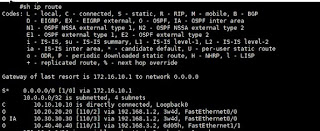Routing Commands
Well as per my 2.5 + years of experience I know that the Troubleshooting is about three big things: predicting what can happen, determining the anomalies, and investigating why that anomalies happened. also the many network admins break down network infrastructure problems by analyzing the Layer 3 path through the network, hop by hop, in both directions.
Below are the basic commands which can help you with Troubleshooting
- Ping
- Show Interface
- Show IP Interface
- Traceroute
- Show Protocols
- Show IP Protocols
- Telnet
- Show running-config
- show IP route
- Show IP protocol database
PING
The first most commonly used command is Ping. The ping stands for Packet Internet Groper. It operates in the network layer of the OSI Model and uses the ICMP protocol. It is the first command you must use while troubleshooting a network. The ping command allows you to test whether there is a connectivity between two devices or not.
For example, PC 1 and PC 2 are connected to a Router with the IP Address. For checking the connectivity, from the PC 1 run the command Ping 172.16.9.70 and If you get TTL means the connection has been established.
Show Interface
This command helps you to know the current status of the interface (port) which include whether the port is up or down, what is the IP Address assigned to it, its data transmission mode, etc.
Show IP Interface
This command helps you to know the current status of the interface (port) which includes the Ip Address, Broadcast Address and also tells you whether the port is up or down.
Traceroute
The Traceroute command traces the end-to-end path a packet takes through an internetwork. It allows you to trace the exact route to which the data travel in the network.
Show Protocol
This protocol only displays the current status of interfaces in Router and its IP Address. This command is useful if you only want to check the IP Address of all the interfaces in the router.
Show IP Protocol
This command helps you to identify which protocol is configured in your router.
Telnet is a protocol that allows you to connect to remote computers (called hosts) over a TCP/IP network (such as the internet). Telnet command allows you to access router and configure it via remote connection.
To take the remote connection of a router, run the command telnet Host IP Address (IP Address of the PC you want to access remotely)
For example, I want to take a remote connection of Router 4 from Router 1. So, I will run the command
Telnet 3.0.0.2
Show running-config
This is the most important routing troubleshooting command. It displays you the entire configuration you have made on the router. It will show you all the commands which you have run on the router which includes the hostname, IP Address, Clock Rate, and the route.
Show IP route
This routing command allows you to check all the route to reach all the destination.
|
Show IP protocol database
This is the last command on the list of Top 10 CCNA Routing Troubleshooting commands. Show IP protocol database work on EIGRP and OSPF protocol. It displays the networks assigned to a different area.









Comments
Post a Comment